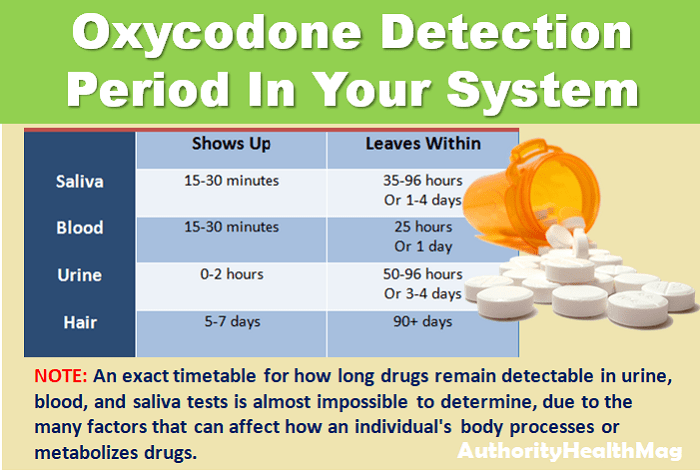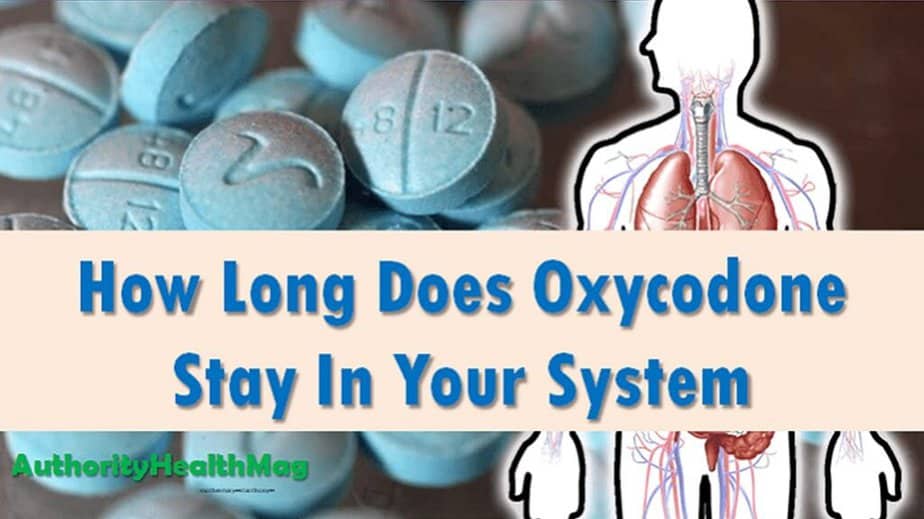Regarding pain relief, Oxycodone is one of the proven medicines you can use. But the fact that this medicine can be addictive and cause side effects can be a big problem for the person who takes it.
So, it is worth learning ‘how long oxycodone stays in your system’, which includes urine, blood, saliva, and hair.
How long Oxycodone lasts in your body depends on several factors, like the user’s age, sex, health condition, dosage, and frequency of use.
The oxycodone drug test is needed to see if the drug is in your urine, blood, saliva, or hair.
What is Oxycodone?
Oxycodone is an opioid medication that is used for pain relief.
Oxycontin and Percocet are the most popular brands of this opioid.
This drug relieves pain by interrupting the central nervous system that receives pain signals. The influence of this medication prevents your body from sending pain signals to the brain.
Unfortunately, Oxycodone has a high risk of dependency and addiction. This medicine is classified as a Schedule II drug highly susceptible to drug abuse.
Pain caused by trauma, injury, cancer, or major surgery is usually treated with Oxycodone.
Hydrocodone is the closest substitute for Oxycodone. Both are strong prescription opioid (narcotic) pain relievers like fentanyl, methadone, and morphine.
Oxycodone can be taken alone or paired with paracetamol or acetaminophen (such as in Percocet, Roxicet, Oxycet, Vicodin, Lortab, and Norco). This combination is recommended for treating moderately severe pain, fever, and inflammation.
Oxycodone is derived from the poppy plant. It binds to the mu-opioid receptors and blocks the feeling of pain.
How long does it take Oxycodone to work?
The analgesic effect of Oxycodone and the time required for it to work can vary from person to person.
For first-time users, lower doses are given initially. Then the doses may be gradually increased until satisfactory relief from pain is achieved.
If a person has used opioids in the past, they may need a higher dose of Oxycodone to relieve pain.
Oxycodone is administered in oral pill form and should be taken just before or after meals.
Most people feel better about their pain 20 to 30 minutes after getting it. This opioid reaches its peak concentration in the bloodstream between 1 and 2 hours after consumption. Extended- or controlled-release formulations may take up to 4 hours to reach their peak concentration in the bloodstream.
Patients using Oxycodone for a long period can develop tolerance to this drug. After a few months of regular use, it may take longer to experience pain relief after the regular dose. In such a situation, the doctor may recommend the patient increase the dose or use a different type of pain relief medicine.
It would help if you never took a larger dose of Oxycodone on your own without your doctor’s recommendation.
How Long Does Oxycodone Last?
It is not safe to have pain relief medicines in high doses. It would help if you did not take another dose of this medicine when the effect of the previous dose still lasts.
So, you may be wondering how long the effects of Oxycodone last in your body.
If you are planning to stop using the medicine, it should be done at a slow pace. Abruptly stopping the use of an opioid can cause withdrawal symptoms.
For most people, the feeling of pain relief from Oxycodone stops long before the residues of this medication clear the body. For this reason, your doctor may ask you to have one dose of Oxycodone every four to six hours when you have continuous pain.
So, the pain-relieving effect of Oxycodone lasts about 6 hours. The effect of a single dose of an extended-release formulation of this drug may last up to 12 hours.
Half-life of Oxycodone
The half-life of a drug is the period required for the concentration or amount of drug in the body to be reduced by half.
Oxycodone has an average half-life of 3.2 hours, while the half-life for the extended-release version (OxyContin) is about 4.5 hours.
On the other hand, the drug’s half-life can be different for each person because of different factors.
From what I’ve heard, the half-life of Oxycodone can be anywhere from 3 to 5.5 hours.
It means that in less than 5 hours, nearly half of the last dose of this medicine will be cleared out of your body.
At this rate, a potentially effective portion of the drug will be fully cleared out of the body in approximately 20 hours.
How Long Does Oxycodone Stay in Your System?
The half-life of Oxycodone can tell you how long it will stay in your system.
The half-life of this opioid is about 3.2 hours. It is the average time taken by your body to eliminate one-half of the medicine. Controlled or extended-release formulations of Oxycodone may take up to 5.6 hours to reach their half-lives.
It will take several half-lives for this opioid to be fully eliminated from your system. As the initial half-life of Oxycodone is 3.2 hours, it will take approximately 24 hours for this medicine to clear your system entirely.
However, the metabolites of Oxycodone will continue to stay in your system for much longer.
Various Oxycodone drug tests can trace the presence of the metabolites of this drug in the blood, urine, saliva, and hair.
Drug Testing for Oxycodone
Methods that aren’t invasive and can be done in secret are used to find metabolites of drugs in your body. It involves the examination of samples collected from the patient, like blood, urine, saliva, and hair.
Depending on the type of drug test, there are different times when the drug can be found in your body.
Urine
How long does Oxycodone stay in your urine?
Generally, a urine test is the most reliable method to detect short-term drug abuse, with a detection window ranging from 4 hours to 8 days.
A urine sample collected from you is analyzed to detect traces of the drug.
Anecdotal evidence from studies says that Oxycodone can stay in your urine for 3 to 4 days after your last dose of this medication.
If you have been using this drug regularly for a long period or in high doses, the metabolites of it may be detectable in the urine for up to 8 days.
Within 4 hours after you had the last dose, Oxycodone was traceable in your urine.
Blood
How long does Oxycodone stay in your blood?
A blood drug test involves the technical analysis of the blood sample. Usually, the blood is extracted from a vein on the back of your palm or the inner area of the arm with a needle.
Unlike urine analysis, the blood test detects only the presence of the parent drug. It is difficult to detect the inactive metabolites of a drug in the blood. For this reason, a blood test provides only a short window for detecting drugs.
Oxycodone stays in your blood for about 24 hours. It is detectable in the blood after 15 minutes of this medicine’s last dose.
Saliva
How long does Oxycodone stay in your saliva?
An oral fluid test offers a short-term window for drug detection. Saliva testing is the easiest and most reliable method to detect the presence of the parent drug and its metabolites in your body.
A high concentration of Oxycodone can be detected in the saliva for 24 hours. Its metabolites can be detected in saliva for up to 4 days.
Usually, the drug can be found in the saliva 15 minutes after it has been taken by mouth.
Hair
How long does Oxycodone stay in your hair?
A hair drug test, also known as a ‘hair follicle drug test’, screens for the presence of drugs or narcotics used by a person.
It is done by collecting a few hair samples and analyzing them for traces of a drug last consumed.
Usually, the metabolites of opioid drugs are detectable in a hair follicle test up to 90 days after taking the last dose of the drug.
So, the metabolites of Oxycodone stay in your hair for up to 90 days.

Influential Factors
The speed at which Oxycodone clears your body depends on a few factors about each user. They include:
Gender
Studies have found that healthy women have a 25 percent higher level of Oxycodone than healthy men. There is no scientific explanation for why the properties of Oxycontin, Oxycodone, or Xtampza ER have a higher concentration in women.
Age
Studies suggest that older adults take a longer time to clear Oxycodone from their systems in comparison to healthy young adults. Persons over 50 usually have up to 15 percent higher concentrations of this drug than younger adults.
Renal function
People with kidney disorders will take much longer to clear opioids like Oxycodone, Oxycontin, and others from their system.
Healthy liver function
The liver is primarily responsible for processing opioid drugs. People who have liver dysfunction take a much longer time to reach the half-life of Oxycodone. An average increase of 2.3 hours can be needed to reach the half-life point of drug concentration due to liver dysfunction.
A lack of certain essential enzymes in the liver can also delay the metabolization of opioids.
Frequency and duration of usage
When a person consumes Oxycodone regularly for a long time, a substantial amount of the metabolites of this drug accumulate in fatty tissues. For this reason, the metabolites of the drug stay in the body for a longer period.
Alcohol consumption
Alcohol consumption increases the effects and retention of Oxycodone. For alcoholics, a much longer time is required for the drug to clear the system.
Interaction with other medications
Opioid medicines like Oxycodone are cleared from the body through cytochrome P450 3A (CYP3A) pathways. But other drugs can inhibit or block CYP3A4 pathways. This delays the clearance of opioids from your system.
Some common drugs that can stop cytochrome P450 3A from doing its job are macrolide antibiotics, azole antifungal drugs, and others. Drugs like rifampin that induce CYP3A can also reduce the effects of Oxycodone.
Metabolic rate
Your basal metabolic rate affects how quickly you take in and get rid of a drug. If you have a healthy metabolic rate, your system will metabolize and excrete Oxycodone and other drugs quickly.
pH Level
Oxycodone is mostly eliminated from the body via renal functions. So, your urinary pH level can significantly impact the excretion process. If you have a high alkaline content in your urine, it will take much longer to remove Oxycodone.
The Bottom Line
The pain relief effect of a single dose of Oxycodone lasts for 4 to 6 hours.
Controlled or extended-release formulations of this drug can last up to 12 hours.
How long Oxycodone stays in your body depends on factors like age, gender, liver function, kidney function, and others.
Oxycodone’s metabolites can be found in the urine and saliva for up to 4 days. It may not be traceable in the blood after 24 hours from the last dose. In hair follicles, the metabolites of opioids may stay for up to 90 days.
Recommended reading list:
- How Long Does Methadone Stay In Your System
- How Long Does Molly Stay In Your System
- How Long Does Suboxone Stay In Your Body
